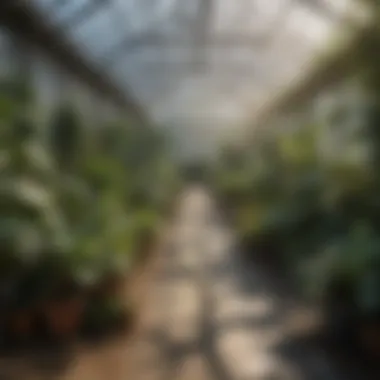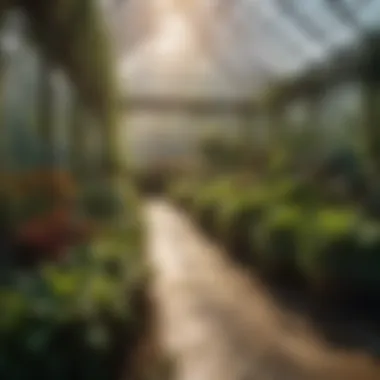Designing the Perfect Greenhouse Floor Plan


Intro
Creating a greenhouse involves more than just erecting a structure to hold plants. An effective floor plan is central to optimizing growth and maximizing the use of space. For anyone invested in greenhouse operations, whether a novice or a seasoned expert, understanding how to arrange the interior layout strategically can yield significant benefits. This article will cover various aspects of floor planning, focusing on elements like plant arrangement, airflow, and lighting. Through careful design, one can create a thriving environment conducive to plant growth.
Key Considerations for an Effective Greenhouse Design
In designing a greenhouse, several factors come into play. These include:
- Layout: The arrangement within the greenhouse is vital to ensure all plants receive necessary light and nutrients.
- Airflow: Proper ventilation is essential in preventing disease, especially in densely planted areas.
- Lighting: Natural and artificial lighting must be balanced to facilitate optimal photosynthesis.
- Accessibility: Pathways and areas for maintenance should be incorporated.
Creating a balanced environment within the greenhouse requires attention to these details.
Plant Arrangement and Its Implications
How plants are placed in a greenhouse can impact growth efficiency.
- Density: Ensure that plants are not overcrowded. Overcrowding can lead to competition for light and nutrients, increasing the risk of disease.
- Compatibility: Some plants thrive better together. Research companion planting to optimize growth.
- Vertical Space: Utilize vertical gardening methods where applicable, to improve space efficiency.
Understanding these dynamics can help in establishing a resilient greenhouse ecosystem.
Ventilation and Airflow Strategies
Effective airflow is crucial in a greenhouse setting. Poor ventilation can lead to heat buildup and humidity, creating an environment conducive to mold. Consider:
- Natural Ventilation: Use vents at opposite ends to allow for cross airflow.
- Fans: Strategically placed fans can enhance air circulation, particularly during hot weather.
- Ducts: HVAC systems may be necessary for larger greenhouses.
Implementing these methods ensures that air quality remains optimal.
The Role of Lighting
Light is a fundamental component in the growth cycle of plants. Factors to consider include:
- Orientation: Place plants in a way that maximizes exposure to sunlight.
- Supplemental Lighting: Use artificial lights during low sunlight periods or in winter months.
- Light Reflectors: These can help distribute light more evenly throughout the greenhouse.
By focusing on effective light strategies, one can foster robust plant health.
Space Utilization Techniques
Efficient use of space encourages productivity and enhances the aesthetic of the greenhouse. Techniques include:
- Shelving: Elevated surfaces can create additional layers for planting.
- Row Orientation: Arrange rows to face south for better sun exposure.
- Garden Beds: Raised beds can improve drainage and soil quality.
Optimizing layout increases overall yield and makes routine tasks easier.
End
"A well-designed greenhouse is not just a structure; it is a living environment that nurtures growth."
Preface to Greenhouse Design
Creating an effective greenhouse design is crucial for achieving successful plant growth and maximizing productivity. A greenhouse functions as a micro-environment; thus, its layout must be meticulously planned. This ensures not only optimal plant health but also efficient use of space and resources.
Importance of a Well-Structured Floor Plan
A well-structured floor plan is the backbone of any greenhouse operation. It influences every aspect of greenhouse performance. Here are some reasons why having a thoughtful layout matters:
- Efficiency: A solid floor plan promotes workflow. It allows for easier movement between plant areas, storage, and equipment, thus saving time.
- Plant Health: Strategic spacing reduces competition for light and nutrients. Proper arrangement can also help with pest management and ease of access for maintenance.
- Resource Management: An organized layout aids in optimal use of water and nutrients, avoiding wastage. It also helps in managing heating and cooling needs.
"The success of a greenhouse hinges on the quality of its design, making layout a key consideration for growers."
In short, disregarding the floor plan can lead to inefficiencies and unmet plant needs. It can also increase operational costs, emphasizing the critical nature of this step.
Overview of Greenhouse Types
Understanding the various types of greenhouses available is essential for making informed design decisions. Each type has unique characteristics that serve specific agricultural purposes. Here are the primary greenhouse types:
- Lean-to Greenhouses: Attached to an existing structure, these utilize the warmth and shelter of the building, maximizing space and energy efficiency.
- Freestanding Greenhouses: They offer flexibility in location and design, often resulting in larger areas for more extensive operations.
- Rooftop Greenhouses: These utilize unused building rooftops, presenting opportunities in urban settings. They can contribute to local food production and reduce urban heat.
Selecting the right greenhouse type impacts both the floor plan and the operational efficiency. The choice depends on your specific goals, available space, and the local climate conditions, thus setting the stage for subsequent design considerations.
Key Elements of a Greenhouse Floor Plan
The floor plan of a greenhouse is crucial as it dictates how effectively the space will be utilized. A well-thought-out floor plan helps foster optimal growth conditions for plants, enhances workflow, and maintains efficiency in operations. By examining key elements within the floor plan, we can ascertain how factors such as size, access, and plant arrangements contribute to the overall productivity of the greenhouse. This section will detail these critical aspects, emphasizing their role in creating a sustainable and effective greenhouse environment.
Size and Dimensions Considerations
Determining the size and dimensions of the greenhouse is one of the first steps in planning. The total space allocated affects everything from plant growth to moisture retention and air circulation. One must consider what plants will be grown and their specific spatial requirements.
- Height and Width: Tall plants like tomatoes need vertical space for proper growth. Meanwhile, wider greenhouses allow more room for walkways and equipment, improving accessibility.
- Future Expansion: Ensure to factor in possible future growth. Planning for a slightly larger space can minimize disruption later.
By aligning the size with specific cultivation goals, the greenhouse can optimize environmental conditions, leading to better yields.
Access and Workflow Efficiency
Efficient workflow is essential for maintaining a productive greenhouse. Access paths should be clear and allow easy movement of equipment and personnel. Here are key considerations:


- Placement of Access Points: Position entrances and exits strategically to minimize travel time between frequently visited zones such as watering stations and storage areas.
- Zoning: The layout should establish zones for various activities, like planting, harvesting, and storage. This prevents cross-contamination and promotes a smooth workflow.
- Accessibility: Ensure that all areas are easily reachable for maintenance, which can save time and resources.
"An efficient greenhouse floor plan not only increases productivity but also decreases labor costs through streamlined processes."
Plant Arrangements for Optimal Growth
The arrangement of plants within the greenhouse must be carefully planned to ensure that each species receives the appropriate amount of light, air circulation, and space to grow.
- Species Grouping: Grouping plants with similar needs helps streamline care routines. For example, shade-loving plants should be placed under larger varieties to maximize light exposure for all.
- Spacing: Adequate spacing prevents overcrowding, which can lead to competition for resources and increased susceptibility to disease.
- Vertical Gardens: Consider vertical gardening techniques where appropriate. This maximizes usage of space and allows for better light distribution.
Light Management in Greenhouse Design
Effective light management is crucial in greenhouse design. Plants require light for photosynthesis, which is essential for their growth and health. Proper light management can enhance crop yields, reduce energy costs, and optimize the internal environment of the greenhouse. By understanding how light interacts with plants and the greenhouse structure, designers can create an environment that maximizes light exposure while minimizing losses.
Natural Light Sources
Natural light is often the primary energy source for plants in a greenhouse. Sunlight provides the full spectrum of light needed for photosynthesis, making it essential for plant growth. The orientation and design of the greenhouse structure significantly impact the amount of natural light received.
When planning a greenhouse, consider the following factors:
- Location: The climate and geographical location influence sunlight availability. Areas with long daylight hours might benefit from a more open design.
- Roof Orientation: The angle of the roof affects how sunlight enters the greenhouse. A south-facing roof can capture more sunlight throughout the day.
- Material Selection: Transparent materials like polycarbonate or glass allow maximum light penetration. However, over time, dust and grime can reduce light efficiency.
Optimize natural light by keeping plants clear of obstructions such as shading from nearby trees or structures. Additionally, using reflective materials within the structure can enhance light distribution, reaching plants at different heights.
Supplemental Lighting Options
While natural light is vital, there are times when additional lighting is necessary. This is especially true during the winter months or in regions with less sunlight. Supplemental lighting can provide a controlled environment that promotes healthy plant growth.
The most common supplemental lighting options include:
- LED Lights: These are energy-efficient and can be tailored to emit specific wavelengths beneficial for plant growth, such as red and blue light for photosynthesis.
- Fluorescent Lights: Often used in smaller greenhouses, these provide a good balance of energy consumption and light output.
- High-Intensity Discharge (HID) Lights: These lights produce a high amount of light but consume more energy. They are suitable for commercial applications where maximizing plant growth is critical.
When incorporating supplemental lighting, consider
- Light Cycles: Proper timing is crucial. Most plants respond best to a light cycle that mimics natural day-length patterns.
- Integration with Control Systems: Automating the light systems can optimize energy use while ensuring plants received the required light.
Climate Control Mechanisms
Climate control mechanisms are vital in greenhouse design. They ensure the optimal environment for plant growth. When the temperature and humidity are not controlled, plants may struggle to thrive. Climate control mechanisms include various strategies that adapt to external weather conditions while maintaining ideal internal conditions. Selecting the right mechanisms can enhance productivity and sustain the operational functionality of the greenhouse.
The benefits of effective climate control include:
- Enhanced plant growth: Optimal conditions enable plants to photosynthesize efficiently.
- Pest and disease management: Proper climate reduces the risk of pest infestations and plant diseases.
- Resource management: Efficient systems can save energy and water, promoting sustainability.
As greenhouse operators aim for maximum efficiency, the strategies implemented can directly impact crop yields and operational costs. Thus, a comprehensive understanding of climate control is essential.
Temperature Regulation Strategies
Temperature control is crucial for a successful greenhouse operation. Plants have specific temperature ranges for optimal growth. If the temperature fluctuates significantly, it can hinder development.
Common temperature regulation strategies include:
- Thermal screens: These reduce heat loss during colder months while preventing overheating on warm days.
- Fans and vents: Proper airflow can distribute temperatures evenly, preventing hot or cold pockets.
- Heating and cooling systems: Options like gas heaters or evaporative coolers work to swiftly adjust temperature settings.
Implementing these strategies effectively involves considering the local climate and the specific needs of the plants being cultivated. This tailored approach can ensure that the plants receive appropriate thermal conditions throughout the year.
Humidity Control Techniques
Humidity plays a vital role in a greenhouse environment. The right levels of humidity can enhance plant growth, while too much or too little can be detrimental. Monitoring humidity levels ensures that plants maintain proper water uptake and reduces the risk of diseases.
Effective humidity control techniques include:
- Dehumidifiers: These machines remove excess moisture from the air, especially useful in humid climates.
- Misting systems: These can increase humidity during dry spells without over-saturating the plants.
- Ventilation: Properly placed vents allow for fresh air exchange, which can help regulate moisture levels.
Achieving and maintaining proper humidity requires ongoing assessment and adjustment. Operators should regularly measure humidity and modify strategies as needed to meet the dynamic conditions of the greenhouse.
Maintaining the right climate in a greenhouse is not merely about comfort; it is about creating an environment where plants can flourish under optimal conditions.
Ventilation and Airflow Management
Ventilation and airflow management is crucial in greenhouse design. Proper ventilation systems help create an environment conducive to plant health by regulating temperature and humidity. Assigning attention to these factors can lead to better plant growth, more efficient energy use, and overall enhanced productivity. Without adequate airflow, conditions may become stagnant, risking mildew, mold, and pest infestations that can threaten a gardener's hard work.
The goal of an effective ventilation system is to balance airflow throughout the entire greenhouse. This requires a strategic layout and a deep understanding of how air moves within a given space. As heat and humidity build up, stagnant air can lead to health problems for plants and reduced yields. Thus, every greenhouse should prioritize systems ensuring fresh air circulation.
Types of Ventilation Systems
Greenhouses primarily utilize two types of ventilation systems: natural ventilation and mechanical ventilation.
- Natural ventilation relies on external environmental factors such as wind and temperature differentials to circulate air. It incorporates vents, windows, and fans that can be opened or closed. This method is often more sustainable, as it requires less energy.
- Mechanical ventilation includes powered fans and motorized systems designed to control air movement actively. These systems can effectively regulate temperature and humidity, especially in larger or more complex structures.
Often, a combination of both methods provides the best results. The choice depends on factors like greenhouse size, local climate, and the specific horticultural needs.
Airflow Patterns and Their Importance
Understanding airflow patterns within a greenhouse is essential for maximizing effectiveness. Airflow can be classified into three general categories: cross-flow, upward, and downward. Each type influences how air interacts with plants and structures.
- Cross-flow ventilation occurs when cool air enters from one side of the greenhouse while warm air exits the opposite side. This pattern is ideal for preventing localized hot spots.
- Upward airflow is beneficial in providing consistent temperature control. Fans placed near the ground floor can push warm air upward, creating a uniform heat distribution.
- Downward airflow occasionally comes from air distribution systems that blow air downward, often used in combination with heating systems.


Understanding and managing these airflow patterns can reduce energy costs and create healthier growing conditions.
The right ventilation strategies lead to improved plant resilience and overall greenhouse efficiency.
"Proper ventilation is not a choice but a necessity for maintaining a thriving greenhouse."
Watering and Irrigation Systems
Watering and irrigation systems play a crucial role in the success of a greenhouse. They not only ensure that plants receive the right amount of water but also help maintain the ideal soil moisture content necessary for optimal growth. The delicate balance of water supply can directly affect the health of plants, so optimizing these systems is vital. With the right approach, greenhouse managers can improve efficiency and conserve water resources, making their operations more sustainable.
Efficient Watering Techniques
Implementing efficient watering techniques is fundamental for maximizing the benefits of greenhouse cultivation. Here are several methods worth considering:
- Drip Irrigation: This technique delivers water directly to the root zone of the plant, minimizing evaporation and runoff. It is particularly useful for high-value crops and can be easily automated.
- Soaker Hoses: Unlike traditional sprinklers, soaker hoses allow water to seep through the hose material, providing even moisture. This is beneficial for rows of plants in garden beds.
- Capillary Mats: These mats draw water from a reservoir below and supply it to potted plants via capillary action. They minimize water waste and are suitable for smaller greenhouse setups.
By carefully selecting watering techniques, growers can enhance water conservation and promote uniform moisture levels throughout the greenhouse.
Rainwater Harvesting Concepts
Rainwater harvesting is another strategic method worth integrating into greenhouse watering practices. Collecting and utilizing rainwater offers several advantages:
- Cost Efficiency: Using harvested rainwater can significantly reduce water bills, especially in areas where water costs are high.
- Environmental Benefits: It conserves potable water and reduces runoff, which can pollute local waterways.
- Temperature Regulation: Collected rainwater is typically at a moderate temperature, reducing thermal shock to plants upon watering.
Implementing rainwater harvesting systems requires some considerations:
- Collection System: Proper gutters and downspouts to channel rainwater into storage tanks.
- Storage Tanks: Ideally made from food-grade materials to ensure water quality.
- Filtration and Treatment: Necessary to remove debris and contaminants before use.
By adopting rainwater harvesting, greenhouse managers can create a more resilient and sustainable watering system.
Efficient irrigation and rainwater harvesting can lead to a dramatic improvement in both cost-effectiveness and productivity in greenhouse operations.
Soil and Nutrient Management
Soil and nutrient management is a fundamental aspect of greenhouse operations. The quality of soil significantly affects plant health and growth. Understanding soil composition and nutrient availability leads to higher yields and better quality crops. Managing these factors not only promotes ecological balance but also improves sustainability in greenhouse farming.
Soil Composition Considerations
The foundation of any successful greenhouse is its soil. Various elements compose soil, including minerals, organic matter, water, and air. Each component plays a role in nutrient availability and plant growth.
Key Elements of Soil Composition:
- Minerals: These provide essential nutrients such as nitrogen, phosphorus, and potassium. Their presence impacts the physical and chemical properties of the soil.
- Organic Matter: This enhances soil structure and moisture retention. Organic materials improve microbial activity and nutrient cycling.
- Soil Structure: Proper soil texture affects drainage and aeration. Clay, sandy, and loamy soils have distinct characteristics that influence water retention and root penetration.
- pH Levels: Soil acidity or alkalinity influences nutrient availability. Most plants thrive in slightly acidic to neutral pH levels (around 6.0 to 7.0).
Regular soil testing is crucial. It informs decisions on amendments and fertilizers for maintaining optimal conditions.
Fertilization Approaches
Fertilizers are necessary for supplying additional nutrients to the plants. However, their application requires careful consideration to avoid environmental impacts and ensure plant uptake.
Common Fertilization Strategies:
- Organic Fertilizers: Derived from natural sources, they release nutrients slowly. Examples include compost, manure, and bone meal. They improve soil structure and microbial life.
- Synthetic Fertilizers: These provide nutrients in readily available forms. They are often used for enhancing growth rates. Careful application is necessary to prevent nutrient runoff.
- Foliar Feeding: This involves applying nutrients directly to plant leaves. It is beneficial for quick nutrient uptake, especially in cases of deficiency.
Best Practices for Fertilization:
- Conduct Soil Tests: Understand existing nutrient levels and pH.
- Follow Recommended Guidelines: Adhere to application rates to prevent over-fertilization.
- Monitor Plant Health: Adjust fertilization based on plant response and growth stages.
"A well-managed greenhouse soil and nutrient system leads to sustainable productivity."
Integrating these practices promotes a healthier environment for plant growth. It is essential for maintaining the long-term viability of greenhouse production.
Choosing the Right Plants for Your Greenhouse
Choosing the right plants for a greenhouse is fundamental to maximizing both the efficiency and productivity of the space. Each plant has unique needs in terms of light, water, temperature, and humidity. Selecting plants that thrive in your specific greenhouse conditions ensures optimal growth and minimizes waste. Additionally, the right selection can enhance the overall ecology of the environment, attracting beneficial insects and promoting a balanced ecosystem within your greenhouse.
The cultivation of plants necessitates careful consideration of several factors, including the purpose of the greenhouse, the environmental conditions, and the preferences of the grower. Understanding these elements enables a strategic approach to building a thriving greenhouse that meets specific goals, whether they are commercial or for personal use.
Criteria for Plant Selection
When it comes to selecting plants for a greenhouse, there are several critical criteria to consider:
- Climate Compatibility: Understand the temperature and humidity levels in your greenhouse to choose plants that can thrive under those conditions.
- Growth Habit: Consider the growth habits of plants. Some may require more vertical space, while others spread out horizontally. Planning accordingly can help maximize space.
- Market Demand: For commercial growers, choosing varieties that are in demand can improve profitability. Conduct market research to identify trends and preferences.
- Disease Resistance: Select plant varieties known for their resistance to common diseases and pests, reducing maintenance efforts and resource expenditure.
- Harvest Time: Take into account the time it takes for plants to mature. A mix of quick and slow-growing varieties can help maintain a steady production rate.
These criteria aid growers in making informed decisions that take into account not just plant preferences but also agricultural efficiency and economic considerations.
Considerations for Seasonal Variations
Seasonal variations have significant implications when choosing plants for a greenhouse. Different plants have varied growth cycles, and understanding the seasonal dynamics can enhance productivity. Some to consider are:
- Seasonal Planting Cycles: Certain plants may be best suited for specific seasons. Plan planting schedules to ensure a continuous harvest or blooming cycle throughout the year.
- Microclimates Within the Greenhouse: Different areas may have varying light and temperature levels. Recognize these microclimates to position plants in optimal spots for their growth conditions.
- Pest and Disease Pressure: Various pests may be more prominent in certain seasons. Choose plants accordingly to provide a buffer against potential infestations.
- Seasonal Demand Fluctuations: As the seasons change, so do consumer demands in gardening and food production. Plan plant selection in alignment with these trends to maximize sales potential.
Understanding these dynamics enriches the decision-making process involved in creating a successful greenhouse. Therefore, by thoughtfully selecting plants that align with both environmental and market conditions, growers can create a productive and sustainable greenhouse system.
Integrating Technology in Greenhouse Design
In the contemporary era, the integration of technology within greenhouse design is paramount. As greenhouse operations become increasingly complex, the utilization of advanced technology can transform the way a greenhouse functions. This entails not only the efficient management of resources but also the optimization of plant growth conditions. The benefits of using technology in greenhouse design can be substantial, ranging from energy savings to improved yields. By understanding the specific elements of these technologies, stakeholders can make informed decisions that enhance both productivity and sustainability in their operations.


Automation Systems
Automation systems represent a critical advancement in greenhouse management. These systems help streamline various processes, making it easier to control environmental variables such as temperature, humidity, and light levels. Automated climate control systems can save a notable amount of time for greenhouse managers. They minimize the need for manual checks and adjustments and allow for more consistent management of plant conditions.
Some key components of automation systems include:
- Climate Control: Automated systems adjust heating, cooling, and ventilation based on real-time data.
- Irrigation Management: Automated watering systems ensure that plants receive optimal moisture levels according to their specific needs.
- Nutrient Delivery: Fertigation systems can deliver necessary nutrients alongside water, promoting health growth.
Implementing these technologies can lead to increased efficiency in resource use, significant labor savings, and improved crop quality.
Monitoring and Data Analysis Tools
Monitoring and data analysis tools are crucial for informed decision-making in greenhouse management. These tools gather and analyze data concerning environmental conditions and plant health. By utilizing these technologies, greenhouse managers can identify trends and make proactive adjustments to their practices.
Key benefits of monitoring tools include:
- Real-Time Insights: Constant monitoring provides immediate feedback on conditions within the greenhouse, allowing for swift adjustments if needed.
- Data-Driven Decisions: With accurate data analysis, managers can make informed choices that improve plant growth and overall operation efficiency.
- Predictive Analytics: Advanced systems can analyze past data to forecast potential issues, helping to prevent problems before they escalate.
In summary, integrating technology into greenhouse design is essential for achieving a productive and sustainable growing environment. Automation systems streamline operations, while monitoring tools provide valuable insight into plant needs and environmental conditions. Therefore, understanding and utilizing these innovations can have a profound impact on the success of greenhouse operations.
Designing for Sustainability
Designing for sustainability is a cornerstone of modern greenhouse practices. It involves making choices that benefit not only the greenhouse operators but also the environment. As concerns about climate change and resource depletion rise, it is essential to adopt strategies that optimize both productivity and ecological stewardship. In this section, we will explore specific elements, benefits, and considerations regarding sustainable greenhouse design.
Sustainability in greenhouse design can lead to improved efficiency and reduced environmental impact. By integrating sustainable materials and practices, growers can minimize waste and energy consumption. Furthermore, designing for sustainability enhances the resilience of the greenhouse against changing climatic conditions.
Sustainable Materials and Practices
Choosing sustainable materials is one of the first steps in creating an eco-friendly greenhouse. Utilizing materials that are renewable, recyclable, or biodegradable is essential. Options such as bamboo, reclaimed wood, and recycled aluminum can significantly lower the carbon footprint of the structure. Additionally, structural insulation should focus on energy efficiency; materials like polycarbonate panels not only provide insulation but also permit light penetration.
Implementing sustainable practices fosters a healthy ecosystem within the greenhouse.
- Water Conservation: Utilize drip irrigation systems to deliver water more efficiently.
- Composting: Recycle organic waste into nutrient-rich compost, enhancing soil quality and reducing waste.
- Integrated Pest Management: Implement methods that reduce chemical usage and promote beneficial insects.
By prioritizing these sustainable materials and practices, the greenhouse becomes more resource-efficient, ultimately reducing operating costs over time.
Impact on Biodiversity
The impact on biodiversity through sustainable greenhouse design cannot be understated. Biodiversity supports ecosystem functions that are vital for agriculture. When designing a greenhouse, considerations should be made to encourage a variety of plant species.
- Crop Diversity: Incorporating a range of plants can help control pests naturally and reduce dependency on chemical inputs.
- Native Species: Growing native plants can enhance local biodiversity, supporting local pollinators and wildlife.
Increased biodiversity can enhance the resilience of greenhouse ecosystems. A diverse environment is less vulnerable to pests and diseases. By fostering an ecosystem that supports various species, greenhouse operators can contribute positively to the global biodiversity crisis.
"Creating a sustainable greenhouse not only supports the growth of plants but also contributes to the overall health of our planet."
Case Studies of Successful Greenhouse Layouts
Analyzing real-world examples of greenhouse layouts provides valuable insights into effective design strategies. Case studies illustrate how various elements such as plant arrangement, environmental controls, and resource management can maximize productivity and sustainability. This section examines recent innovations and lessons learned from existing projects. These examples reveal practical applications of theoretical principles discussed earlier, making the information relatable and actionable for greenhouse designers.
Analysis of Recent Innovations
Recent innovations in greenhouse design have significantly advanced efficiency and productivity. Examples include the use of state-of-the-art materials that provide better insulation and light diffusion. The implementation of hydroponics and aeroponics systems allows for soil-less cultivation, dramatically reducing water usage. Additionally, smart technology is increasingly in use, where systems automatically adjust conditions based on real-time data.
- Case Study: The Eden Project, Cornwall, UK
This project employs geodesic domes made from hexagonal panels that optimize solar gain and energy efficiency. It serves as an example of how creative architectural design can enhance functionality. The use of a climate control system integrating temperature and humidity monitoring exemplifies modern greenhouse technology. - Case Study: Greenhouse at the University of Arizona
This facility integrates sensors and automation for irrigation and ventilation. Custom layouts designed for optimal airflow and light penetration contribute to healthy plant growth. Such innovations not only improve crop yield but also minimize labor costs and resource waste.
Lessons Learned from Existing Projects
Lessons learned from existing greenhouse projects often reveal pitfalls and successes in design decisions. Understanding these can lead to more informed choices for future developments in greenhouse layouts.
- Importance of Flexibility
Many successful greenhouses demonstrate the need for adaptable designs. Spaces should be able to accommodate different types of plants throughout the growing seasons. For instance, modular systems can provide options for rearranging plants based on growth stages. - Environmental Considerations
Numerous projects highlight the significance of site selection and orientation. Positioning a greenhouse to take advantage of natural light and prevailing winds can reduce energy costs related to heating and cooling. The Kew Gardens, for example, emphasizes natural ventilation methods to promote sustainability.
"The effectiveness of a floor plan becomes evident in how well it supports both the ecological and productivity goals of a greenhouse."
Finale and Future Directions in Greenhouse Design
The design of a greenhouse is not merely about aesthetics. It plays a crucial role in the efficiency and productivity of plant growth. Therefore, understanding the conclusion and future directions in greenhouse design is significant. This section highlights the importance of a well-thought-out floor plan and its ongoing evolution in response to new technologies and environmental considerations.
As we evaluate the designed features and strategies that have previously been discussed throughout this article, it becomes clear that optimal greenhouse design leads to enhanced plant health, resource use efficiency, and overall operational effectiveness. The integration of modern techniques and materials allows for adaptability to various climatic conditions and plant requirements. Therefore, pinpointing the key aspects of these developments is essential for professionals looking to improve their greenhouse facilities.
Moreover, the future direction of greenhouse design revolves around improved sustainability and innovation. As climate change impacts agriculture distinctly, greenhouse design must evolve to meet these challenges while minimizing environmental impacts.
"Effective floor planning combined with advanced environmental control systems can maximize production potential and sustainability in greenhouse operations."
Summary of Key Insights
- Environmental Control - A critical insight is the relationship between greenhouse floor plan and environmental controls such as temperature and humidity management. Efficient layouts facilitate better air flow and heat distribution, leading to healthier plants.
- Automation and Technology - Integrating technology such as sensors and automation systems can streamline processes. This reduces manual workload and enhances monitoring for a more efficient growth environment.
- Sustainable Practices - Utilizing sustainable materials in construction and implementing energy-conscious operations is an emphasis of modern greenhouse design. It promotes not only resource efficiency but also aligns with global sustainability goals.
In summary, the key insights indicate that future designs must continually adapt by harnessing new technologies while focusing on sustainability.
Future Trends in Greenhouse Technology
The future of greenhouse technology is dynamic and multifaceted. It presents several promising trends that could revolutionize how greenhouses are designed and operated.
- Advanced Climate Control Systems
- Vertical Farming Integration
- Data Analytics
- Biotechnology in Plant Production
- These systems monitor and automate optimal growing conditions, adjusting temperature, humidity, and light levels in real-time to enhance plant growth and reduce energy consumption.
- Vertical farming within greenhouses maximizes space and increases plant yield per square foot. This technique responds well to urban farming environments where land is limited.
- The use of data analytics allows for better decision-making regarding crop management. By evaluating climate data, soil health, and growth patterns, growers can achieve optimal performance.
- As plant genetics continue to evolve, biotechnology will create varieties that are more resistant to pests and diseases, requiring less chemical intervention.







